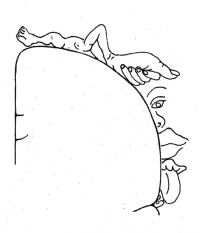October 28, 2009 weblog
Phantom limbs learn impossible tricks

(PhysOrg.com) -- New research has shown that body images can be formed independently of external sensory inputs, and that the phantom limbs of amputees can be trained to carry out tasks that would be impossible for real limbs.
The researchers, Dr Lorimer Moseley, a clinical neurologist currently at the Prince of Wales Medical Research Institute in Randwick, Australia, and Dr Peter Brugger, a Swiss neuroscientist from the University Hospital in Zurich, wanted to find out if it would be possible to change our body image purely by thought. They also wondered whether or not the image created would obey the normal laws of physics if the body part did not actually exist.
Before the experiment the scientists used what is known as a left-right hand judgment test to measure reaction times. In this test the subjects were shown images of hands at extremes of an impossible movement of the wrist and measured the time taken for them to decide whether the image was of a right or left hand. Earlier studies have demonstrated that the reaction time corresponds to how long the actual movement to the position shown would take, since the movement is made in the imagination.
They then asked participants to practice imagining they were rotating the hand through 360 degrees as if it was joined to the arm via pivot. The subjects, all amputees with vivid phantom arms and hands, practiced five minutes an hour every day until they had learned, or until they had given up.
Four of the seven amputees were able to imagine and feel the impossible movement. They reported that at first they felt as though they were watching someone else's hand, but as they learned their perception of their wrist changed to one that would allow the movement, and the rotating wrist felt like part of their own body.
After the experiment their reaction times on the left-right hand judgment test were measured again. Those who had learned to mentally make the impossible movement were faster than before.
Moseley said the experiment showed the brain can create a physiologically impossible way of working the body without feedback from outside, and that body image and self awareness can change dramatically without external inputs. He also said they were surprised to learn that after the experiment two of the amputees found it difficult to imagine their phantom limbs carrying out normal tasks, but this suggests the limbs were adhering to a new set of physics rules.
Moseley said the findings may find practical application in the future in training amputees who experience pain in their phantom limbs to change their body image in a way that will remove the pain. There is also a possibility people with movement problems caused by stroke or intense pain could be trained to change their image of the body part to help reduce the pain or improve movement, and that patients with distorted body image (such as anorexia) could learn to imagine a changed body.
The paper was published this week in the Proceedings of the National Academy of Science.
More information: Interdependence of movement and anatomy persists when amputees learn a physiologically impossible movement of their phantom limb, G. Lorimer Moseleya and P. Brugger, Published online before print October 26, 2009, doi: 10.1073/pnas.0907151106
© 2009 PhysOrg.com














